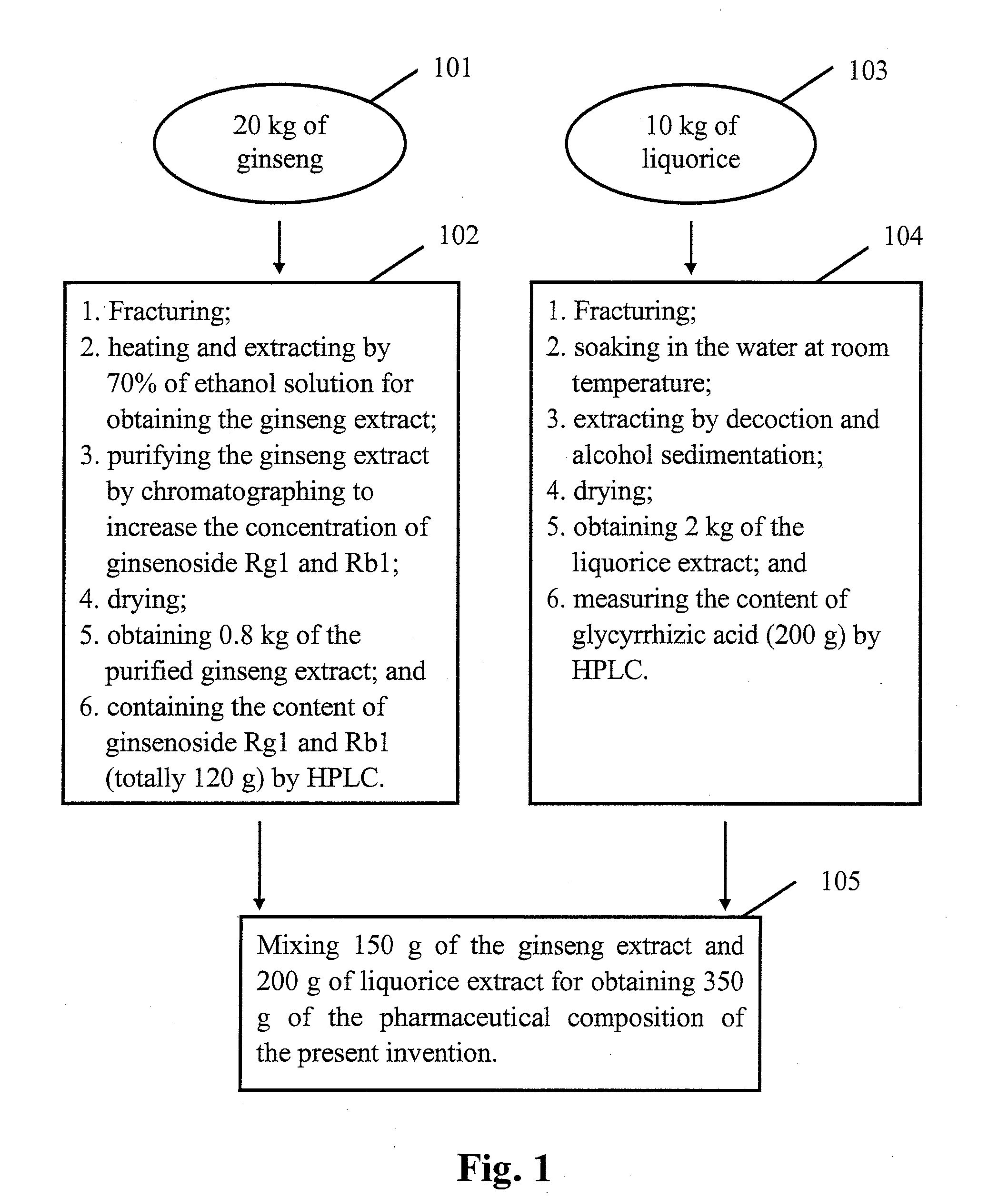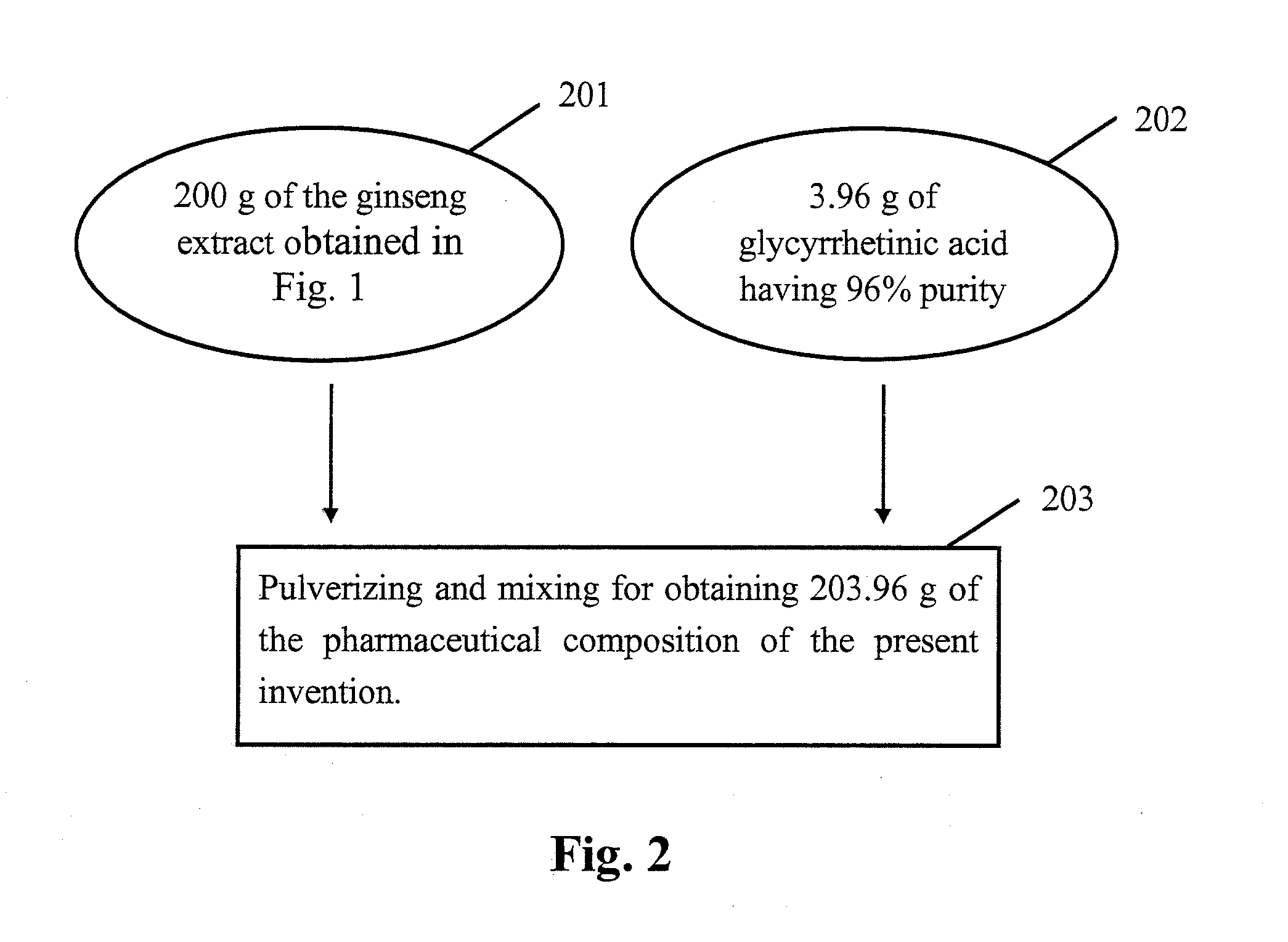[0007]The purpose of the present invention is to provide a pharmaceutical composition or a healthcare food to overcome the insufficiency of the currently available treatments for
anxiety disorder. The pharmaceutical composition or a healthcare food is manufactured from the raw materials including
ginsenoside Rg1 and Rb1, glycyrrhizic acid and jujuba cAMP for treating
anxiety disorder. In particular, the new technical scheme offering definite functions and components, obvious
curative effect, fewer side effects and high safety for long-term usage is provided.
[0008]The technical scheme of the present
medicine is the result endeavored by the inventor. The scheme, employing three raw materials including
ginseng, liquorice and jujuba, is developed based on the
pathological and pharmacological theories of
modern medicine for treating anxiety; specifically, it integrates past pharmaceutical-targeted research with the recent knowledge developed in post-
receptor mechanism.
Ginsenoside from ginseng has adenylate
cyclase (AC) activity to stimulate cAMP synthesis and cAMP
phosphodiesterase (CAPD) inhibitory activity to reduce cAMP breakdown; glycyrrhizic acid (and glycyrrhetinic acid) from liquorice are strong inhibitors of CAPD.
Ginsenoside Rg1 and Rb1 and glycyrrhizic acid when paired and used collectively further increase the concentration and activity of cAMP and
protein kinase A (PKA) respectively in the
organism. The increasing concentration and activity of cAMP can catalyze the
phosphorylation of GABA α / β subunits and
phosphorylation of the β
subunit thereof can amplify the inhibitory function of GABA on neurons to achieve significant anti-anxiety functions. Finally, jujuba cAMP from jujube, being the extrinsic non-hydrolyzable cAMP, can participate in the
metastasis of cAMP in the
organism, stimulating the
enzyme function and effectively increasing the expression of cAMP and PKA in the
organism, to further enhance the anti-anxiety function. Accordingly, the raw materials including
ginsenoside Rg1 and Rb1, glycyrrhizic acid and jujuba cAMP are combined to maximize the effects of anti-anxiety function of the present invention.
Ginseng, liquorice and jujuba are commonly used pharmaceutical materials in Chinese
medicine and have been used in dietary nourishing medicinal meals for several thousand years. In this long clinical and dietary history, the safety and
efficacy of
combined use of ginseng, liquorice and jujuba have been sufficiently proven. The inventor's research and experimental results have shown that if these three pharmaceutical materials are only normally decocted and extracted to obtain the extract, the extract does not have significant anti-anxiety effect compared with the mainstream anti-anxiety medicines of the present technology. However, upon further purification of the extract of these three pharmaceutical materials to increase the concentration of the effective components containing ginsenoside Rg1 and Rb1, glycyrrhizic acid and jujuba cAMP, etc., as described in this invention, a pharmaceutical composition with significant anti-anxiety function is obtained. Animal experimental results clearly demonstrate that the manufactured pharmaceutical composition of the present invention has superior anti-anxiety effect compared with the pharmaceutical composition of the mainstream
medicine,
Diazepam, for treating
anxiety disorder. Furthermore, taking ginseng, liquorice and jujuba would not generate side effects as taking the present mainstream medicines for treating anxiety. Patients would not cease or refuse the pharmaceutical therapy for worrying about the side effects. The inventor thus submits that ginsenoside Rg1 and Rb1, glycyrrhizic acid and jujuba cAMP be the raw materials for manufacturing the pharmaceutical composition or the healthcare food for treating anxiety disorder. In particular, the new technical scheme, which has definite functions and components, high safety for long-term usage without side effects, improves the drawbacks generated in the prior art.
[0009]Glycyrrhetinic acid has higher liposolubility than glycyrrhizic acid and can easily enter the brain through the blood-brain barrier. Since the glycyrrhizic acid is converted to glycyrrhetinic acid in the
human body with almost 100% efficiency, the inhibition of CAPD by glycyrrhizic acid is proceeded by transforming glycyrrhizic acid to glycyrrhetinic acid in the body. Accordingly, glycyrrhizic acid or glycyrrhetinic acid can be the
raw material for manufacturing the pharmaceutical composition of the present invention.
 Login to View More
Login to View More 


